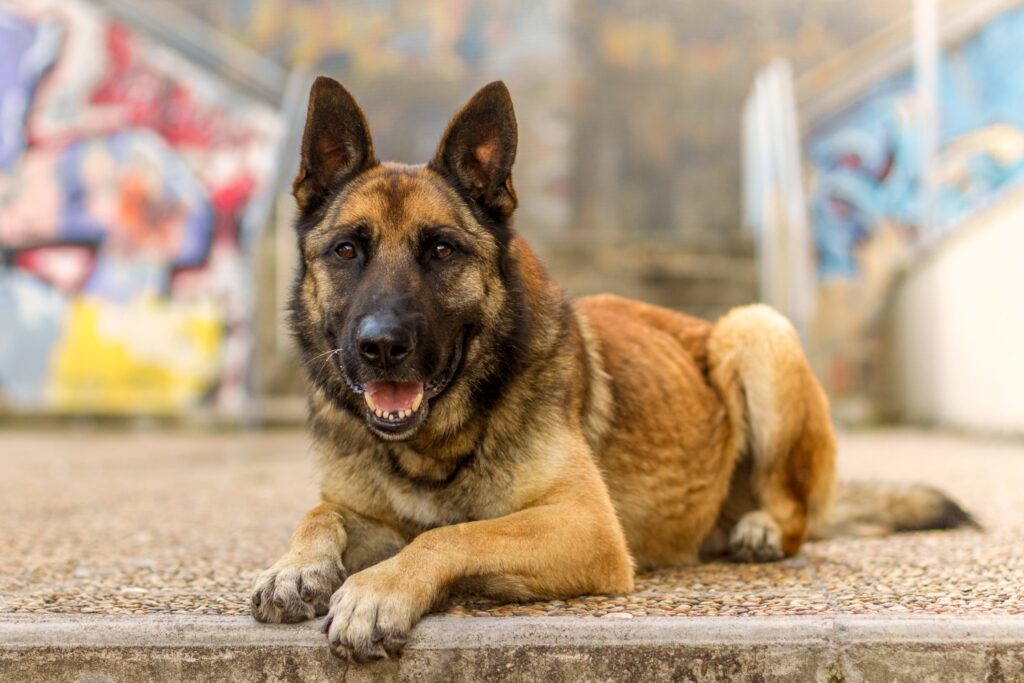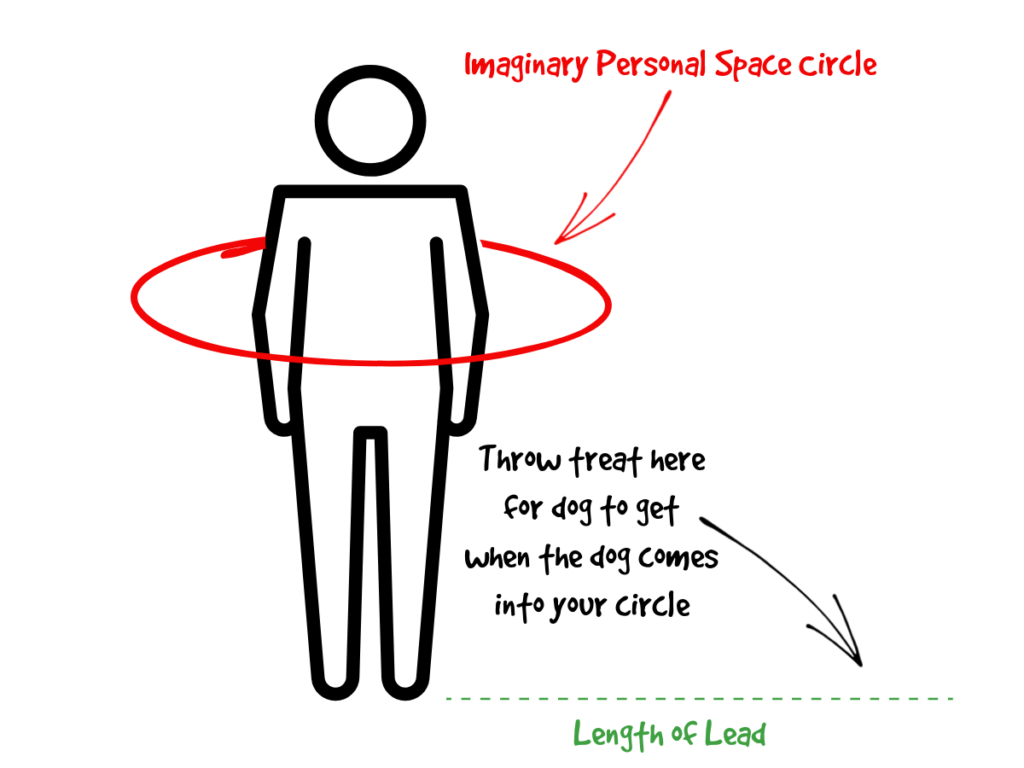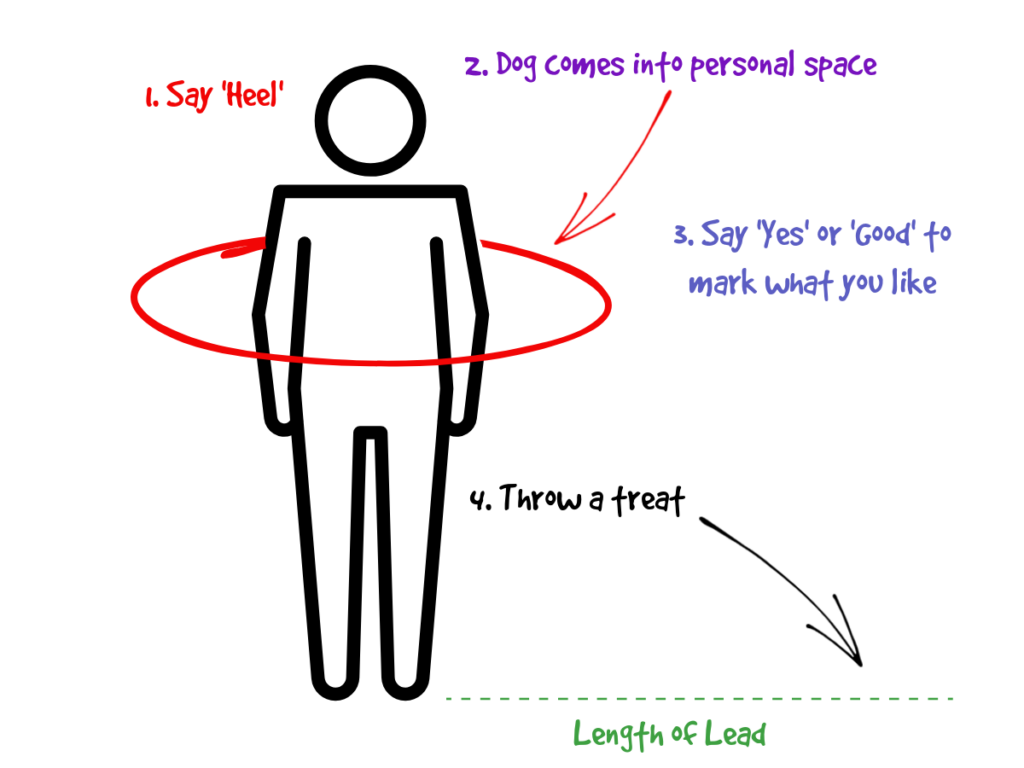Or: how Hagrid taught me to walk to heel.
This month, I’ll be sharing all my tips with you for teaching adult dogs to walk to heel or to walk without pulling on the lead. While puppy programmes are great for teaching puppies to walk without pulling, it can be really difficult to teach a 40kg adult dog not to pull when they’ve spent their whole life doing it, or they’ve not had the training they needed to help them.
Sometimes, that’s just because we’re not helping ourselves when we train our puppies. It’s not just rehomed adult dogs that could do with a back-to-basics course. I know extendable leads are still fashionable; alongside the danger of these devices, they’re absolute sods for teaching dogs to walk under constant lead pressure. They’re the first thing you need to ditch if you have a dog who pulls or lunges on lead, or who spends most of the time looking in the bushes and frantically vaccuuming up smells.
The first tip I have for you comes from a dog who taught me to walk perfectly to heel.
This is Hagrid.
Hagrid was a guest at our shelter for a couple of years, and he taught me very nicely to walk to heel.
Alongside health issues that made him very hungry, he was also a very independent spirit. The first time I saw him, he had a volunteer up against the wall and was helping himself to the contents of said volunteer’s treat pouch. I imagine him a little like a rather dashing highwayman, taking what he wants with latent menace but doing so with pizzazz nonetheless.
Helping himself was natural. I took him once to a photo shoot. That was fun. The student photographers asked me to let him off lead. I told them it wasn’t a very good idea. They insisted. I dropped the lead. Hagrid went to the buffet and ate all the peanuts. Then he went and found surplus in a duffle bag.
I think it’s important you have an understanding of Mr Hagrid and his ways before I tell you how he taught me to walk to heel. Mostly as I don’t want you to think badly about what happened next between us.
When I was walking Hagrid, he had a disconcerting way of giving me a look. A look that said, “Hey lady, give me a treat!” and also, “I’m being polite now… don’t make me mug you…” He was always just that little bit too close to me and I just did not feel relaxed with him right there in my personal space. It was disconcerting and a little unnerving.
He was very obliging and a very hungry, good boy.
I, however, did not like Hagrid walking so close to me. I did not want him up close and personal.
So I threw a treat into the grass.
He went to get it.
I sighed and felt momentary relief.
He turned at me and smiled that gap-toothed smile, then sidled right in again. That dog really did sidle. As unobtrusively as he could, gradually moving in as we moved forwards.
Now I knew this was backwards.
Throwing the treat out was shaping closer and closer behaviours.
It made him come back more, not less.
So I left it longer and longer before I’d throw that treat, figuring he’d just back away or give up walking in my personal space.
He never did.
By the end, he was loose-lead walking almost a kilometre – never begging. Just looking and being there… right at my knee. Just in case, you know.
I’d find him right at my side again.
‘Hullo… I don’t suppose you’d have a treat there for a small dog would you, lady?’
And just like that, he’d taught me the best heel-walk life hack ever.
What was happening was I was shaping him walking in my space. The longer I left it, the closer he’d get, so the next time, he’d just start walking at the previously closest point. So what started being a metre away ended up being 10cm away from me. And then I started to shape longer and longer periods of him being in my space. What started being a treat every ten paces or so ended up being a treat every hundred paces or so.
Hagrid’s loose lead & heel walking method
This is how Hagrid taught me how to walk to heel.
Start in a really easy, familiar space where your dog is relatively calm and able to take food. You can even start in the home if you need to. You can also start on the easy bits of walks – say for instance if your dog is calm(er) as you turn the corner to go home. If you’ve got multiple dogs, train one dog first. You don’t even need to do it on lead.
Instead of looking down and seeing your small, hairy steam train, imagine you have a very handsome but rather unnerving big dog at your side. You want to get them away from you. Every time they violate your personal space, you want to get them out of it. It’s actually helpful to imagine a physical circle or bubble around 50cm or the length of your lower arm from you. Every time they come into it, you’re going to throw them a treat just to get them away from you.
Without going further than the length of the lead, throw a treat 90° to the side of you. It’s best if you’re using a 2 or 3 metre lead. Any longer, and you run the risk of whiplash. Any shorter, and you won’t be able to really move the treat very far away at all. You keep walking slowly – slow enough that you’re still moving but they’ve time to find the treat without the lead going hard. If they’re finding it hard, do this on a clear, flat surface like asphalt, with very smelly and visible big treats. Throw it gently – excitement and loose lead exercises do not mix well.
What you should find happening is an immediate return as the dog comes back.
As soon as they’ve got that treat, they’re back for more.
Reward 20 or so invasions of your personal space every time they violate your imaginary circle.
Make sure you throw to the same side that you want the dog to walk on. Stick to one side.
Eventually, if you like, you can move to a 5 or 10m lead and use smaller treats in the grass so you can take more paces forward while they’re finding it. If they’re slower, you can also stop or slow down until they’ve found it and then start walking again.
It’s so simple: Dog violates your imaginary circle, throw treat sideways.
What you should find is that the dog becomes a real space invader.
Then you can only reward the very worst infractions. Make that imaginary circle smaller.
You don’t even need to mark with a clicker or a marker word like ‘yes’ or ‘good’ – just throw the treat. You can, of course, use a marker word, but marker words are not what make this effective – rewarding the dog with food for being in your personal space is what makes it work. To be honest, with a lead and with treats, I’m not a fan of having something else in my hand, though you can get clickers you operate with your mouth. I prefer a simple verbal marker though – it’s much less cumbersome when you’re on the move.
If you do add a marker word, you’re just moving to a three-step process: dog violates your imaginary circle, say ‘yes’ or ‘good’, throw treat sideways.
You can add a cue if you like. I say ‘ready?’ That just means ‘Come into my space – good stuff is about to start!’ Or you can say ‘heel’ if that’s your thing. To be honest, you could say, ‘Make like Glue!’ if you wanted. No reason it has to be formal.
Make sure it’s a clear word that’s different from all your other words though. If you do this, you’ve now got a four-step process: say ‘heel!’ as the dog approaches the first few times, wait for the dog to move into your imaginary circle, say ‘yes’ or ‘good’ and throw the treat sideways.
To be honest, I’m so lazy, I just keep it pretty loose.
What you do then is stretch out the time that the dog is violating your personal space circle. Do this slowly and incrementally, counting paces if you like. Go two paces with them in your personal space, then throw the treat. Do this six or seven times, then go three paces. Mix it up too and keep it unpredictable. Sometimes throw after one pace. Sometimes after ten. Sometimes five. Keep your dog guessing.
It’s also important to throw the treat when the dog is looking straight ahead. If you can, do it when the dog’s head is held high (as opposed to sniffing the ground) and looking forward, otherwise you’ll end up with the ‘stargazer’ walk where the dog walks next to you but looking up at you as if you’re a celebrity. I hate this. It’s bad for dogs’ necks and they can’t see where they’re going.
If you’re doing show walking for obedience, of course, you may want this.
But for us average Joes and Josephines, it’s better to reward your dog when they are in your space but not looking directly at you. Worse still is rewarding because they’re looking at your pockets or your hands. If your dog struggles with this, don’t engage eye contact with them, look straight ahead. Put your treats away and never touch your pouch or pockets when the dog is looking at them. You can of course do this pocket touching very deliberately. I do. It stops me having to say, ‘Hey, dogs! Make like glue!’ But if you’re going to do this, make sure it’s a choice, not an accident. I love it that I touch my pockets, and my dogs go: ‘Oooh, what? What?!’
You can also just reward the worst infractions and violations of your personal space. I did that with Hagrid. By the end, we were show-walking, shoulder to knee. This was not my intention.
Once you’ve got this, add in progressively more challenging circumstances.
It is perfectly possible to build up to very long stretches, I don’t like this as the dog might as well be on a treadmill. Tilly my spaniel once heelwalked for 5km as I’d left a pig’s ear in my jacket. This was not my intention and she did not enjoy that walk. I tend to use a cue ‘ready?’ or touch my pockets, do a little bit of training and then do an awful lot of dog stuff like sniffing, peeing and investigating in between. Heel work is hard. It also doesn’t allow your dog to do exciting dog stuff.
You can see the technique in action here. Just a caveat – the black dog is on medication that increases his appetite, so there is some stargazer walking here – I’m not that fussed about it because we don’t do loads of demos, otherwise I’d phase it out. The malinois girl is the one to keep your eye on for best technique’. You can also see from time to time, I reward from my hand. That’s fine too.
Why this works
The first reason is that it progressively shapes closer and closer walking. Forget about the lead, really. You can do this without the lead just as well. This is not about a loose lead so much as it is about teaching the dog that it’s worthwhile walking near you. You’re like a walking cash machine that sometimes spits out money. It’s worthwhile hanging around to be there when that happens.
The second is that it teaches your dog where to walk. So many people try to lure the dog in position or use very stilted heel positions that the dog has to concentrate really hard. This method is zero fun. I have never, ever had fun or success teaching a dog to do this. All your dog is learning is the concept that, if they’re near you, they get food.
Throwing the treat sideways is just a test and allows them to reset. It also really helps them understand that it’s being near you that’s valuable. Who knows what dogs are learning if you’re just feeding at your knee or heel? Maybe they’re learning when you bend over, food comes. Trainers do this all the time. I throw treats away when I’m grooming or petting dogs so that I know, if they come back, then they’re okay with what we’re doing. If they eat the food and stay away, then that tells me such a lot. If I want dogs to stay on a platform, throwing the treat away or rewarding off the platform is a crucial step to help dogs realise what it is that they’re doing that’s getting the food. As we always say, the position of the reinforcement is essential. I think this method is better than reinforcing at the side of us because we never can tell if the dogs really understand it. This way, we test all the time if the dog is with us or not. And if they disengage or spend longer getting the treat, that gives me information to slow down and let them investigate.
It’s also a very casual technique that you can practise over time. I tend to reward all violations of my space over a walk with a dog who isn’t that interested in me. Give it a month and you’ll see much more focus on you and much less of the kind of walking you don’t want. This works for me. They sniff and do dog stuff as they like, and when they’re finished with that, then they come back close in and we interact. I’ve found dogs who were completely checked out and never interested in their guardians at all are much more focused on their guardian after a month or so of this technique. It can be very frustrating (and fattening!) to try to teach an adult dog not to pull by doing it as you would with a puppy – not walking them until they’ve mastered heel walking or loose lead in the home, the garden, on easy walks… It could easily be three months of very heavy treat reliance to get that far and that’s frustrating for both dogs and guardians. This way gradually phases out pulling and phases in walking in the proximity of the guardian. It’s not an all or nothing approach and you can do it with ten or twenty high-value treats a day rather than getting through a kilo of cheese and giving your dog pancreatitis. The irony is that the more they’re in your personal space, the leaner and more demanding you can be with rewards.
So, thank you, Mr Hagrid, for having taught me to walk to heel. Your hack helps me daily in so many ways.
This post is the first in a series over the month helping you train your adult dog to walk nicely on lead. If you don’t want to miss a post, hop over to Facebook and ‘Like’ the page, making sure you hit all the right buttons to see posts. Or sign up on this website to get every post delivered to your inbox!








